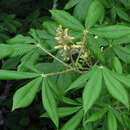en
names in breadcrumbs


Aesculus flava, also known commonly as the common buckeye, the sweet buckeye, and the yellow buckeye, is a species of deciduous tree in the subfamily Hippocastanoideae of the family Sapindaceae. The species is native to the Ohio Valley and Appalachian Mountains of the Eastern United States.[2] It grows in mesophytic forest or floodplains, generally in acid to circumneutral soil, reaching a height of 20m to 48m (65 ft to 154 ft).
The leaves are palmately compound with five (rarely seven) leaflets, 10–25 cm (3.9–9.8 in) long and broad. The flowers are produced in panicles in spring, yellow to yellow-green, each flower 2–3 cm (0.79–1.18 in) long with the stamens shorter than the petals (unlike the related A. glabra, Ohio buckeye, in which the stamens are longer than the petals). The twigs have a faintly rank odor, but much less so than the Ohio buckeye, A. glabra. The fruit is a smooth (spineless), round or oblong capsule 5–7 cm (2.0–2.8 in) in diameter, containing 1-3 nut-like seeds, 2.5–3.5 cm (0.98–1.38 in) in diameter, brown with a whitish basal scar. The fruit is poisonous to humans but can be made edible through a leaching process.
Aesculus flava is cultivated as an ornamental tree. The tree's showy yellow flowers and good autumn color are attractive in larger gardens and in parks.[3]
This plant has gained the Royal Horticultural Society's Award of Garden Merit.[4]
It has been marked as a pollinator plant that attracts hummingbirds and bees.[5]
Native Americans roasted and soaked the poisonous seeds to remove the toxic element and consume them as food.[6]
Aesculus flava, also known commonly as the common buckeye, the sweet buckeye, and the yellow buckeye, is a species of deciduous tree in the subfamily Hippocastanoideae of the family Sapindaceae. The species is native to the Ohio Valley and Appalachian Mountains of the Eastern United States. It grows in mesophytic forest or floodplains, generally in acid to circumneutral soil, reaching a height of 20m to 48m (65 ft to 154 ft).